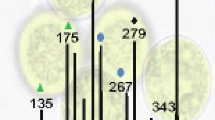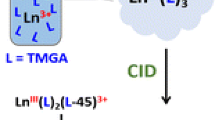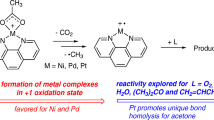Abstract
Fatty acids are long-chain carboxylic acids that readily produce [M – H]– ions upon negative ion electrospray ionization (ESI) and cationic complexes with alkali, alkaline earth, and transition metals in positive ion ESI. In contrast, only one anionic monomeric fatty acid–metal ion complex has been reported in the literature, namely [M – 2H + FeIICl]–. In this manuscript, we present two methods to form anionic unsaturated fatty acid–sodium ion complexes (i.e., [M – 2H + Na]–). We find that these ions may be generated efficiently by two distinct methods: (1) negative ion ESI of a methanolic solution containing the fatty acid and sodium fluoride forming an [M – H + NaF]– ion. Subsequent collision-induced dissociation (CID) results in the desired [M – 2H + Na]– ion via the neutral loss of HF. (2) Direct formation of the [M – 2H + Na]– ion by negative ion ESI of a methanolic solution containing the fatty acid and sodium hydroxide or bicarbonate. In addition to deprotonation of the carboxylic acid moiety, formation of [M – 2H + Na]– ions requires the removal of a proton from the fatty acid acyl chain. We propose that this deprotonation occurs at the bis-allylic position(s) of polyunsaturated fatty acids resulting in the formation of a resonance-stabilized carbanion. This proposal is supported by ab initio calculations, which reveal that removal of a proton from the bis-allylic position, followed by neutral loss of HX (where X = F– and –OH), is the lowest energy dissociation pathway.

ᅟ





Similar content being viewed by others
References
Fahy, E., Subramaniam, S., Brown, H.A., Glass, C.K., Merrill, A.H., Murphy, R.C., Raetz, C.R.H., Russell, D.W., Seyama, Y., Shaw, W., Shimizu, T., Spener, F., van Meer, G., VanNieuwenhze, M.S., White, S.H., Witztum, J.L., Dennis, E.A.: A comprehensive classification system for lipids. J. Lipid Res. 46(5), 839–861 (2005)
Shinzawa-Itoh, K., Aoyama, H., Muramoto, K., Terada, H., Kurauchi, T., Tadehara, Y., Yamasaki, A., Sugimura, T., Kurono, S., Tsujimoto, K., Mizushima, T., Yamashita, E., Tsukihara, T., Yoshikawa, S.: Structures and physiological roles of 13 integral lipids of bovine heart cytochrome c oxidase. EMBO J. 26(6), 1713–1725 (2007)
Brown, S.H.J., Mitchell, T.W., Oakley, A.J., Pham, H.T., Blanksby, S.J.: Time to face the fats: what can mass spectrometry reveal about the structure of lipids and their interactions with proteins? J. Am. Soc. Mass Spectrom. 23(9), 1441–1449 (2012)
Tapiero, H., Ba, G.N., Couvreur, P., Tew, K.D.: Polyunsaturated fatty acids (PUFA) and eicosanoids in human health and pathologies. Biomed. Pharmacother. 56(5), 215–222 (2002)
Serhan, C.N.: Novel eicosanoid and docosanoid mediators: resolvins, docosatrienes, and neuroprotectins. Curr. Opin. Clin. Nutr. Metabolic Care 8(2), 115–121 (2005)
Eder, K.: Gas chromatographic analysis of fatty acid methyl esters. J. Chromatogr. B Biomed. Appl. 671(1/2), 113–131 (1995)
Trufelli, H., Famiglini, G., Termopoli, V., Cappiello, A.: Profiling of non-esterified fatty acids in human plasma using liquid chromatography-electron ionization mass spectrometry. Anal. Bioanal. Chem. 400(9), 2933–2941 (2011)
Tomer, K.B., Crow, F.W., Gross, M.L.: Location of double-bond position in unsaturated fatty acids by negative ion MS/MS. J. Am. Chem. Soc. 105(16), 5487–5488 (1983)
Kerwin, J.L., Wiens, A.M., Ericsson, L.H.: Identification of fatty acids by electrospray mass spectrometry and tandem mass spectrometry. J. Mass Spectrom. 31(2), 184–192 (1996)
Adams, J., Gross, M.L.: Tandem mass spectrometry for collisional activation of alkali metal-cationized fatty acids: a method for determining double bond location. Anal. Chem. 59(11), 1576–1582 (1987)
Hsu, F.F., Turk, J.: Distinction among isomeric unsaturated fatty acids as lithiated adducts by electrospray ionization mass spectrometry using low energy collisionally activated dissociation on a triple stage quadrupole instrument. J. Am. Soc. Mass Spectrom. 10(7), 600–612 (1999)
Hsu, F.F., Turk, J.: Elucidation of the double-bond position of long-chain unsaturated fatty acids by multiple-stage linear ion-trap mass spectrometry with electrospray ionization. J. Am. Soc. Mass Spectrom. 19(11), 1673–1680 (2008)
Poad, B.L.J., Pham, H.T., Thomas, M.C., Nealon, J.R., Campbell, J.L., Mitchell, T.W., Blanksby, S.J.: Ozone-induced dissociation on a modified tandem linear ion-trap: observations of different reactivity for isomeric lipids. J. Am. Soc. Mass Spectrom. 21(12), 1989–1999 (2010)
Davoli, E., Gross, M.L.: Charge remote fragmentation of fatty acids cationized with alkaline earth metal ions. J. Am. Soc. Mass Spectrom. 1(4), 320–324 (1990)
Zehethofer, N., Pinto, D.M., Volmer, D.A.: Plasma free fatty acid profiling in a fish oil human intervention study using ultra-performance liquid chromatography/electrospray ionization tandem mass spectrometry. Rapid Commun. Mass Spectrom. 22(13), 2125–2133 (2008)
Blagojevic, V., Samad, S.N., Banu, L., Thomas, M.C., Blanksby, S.J., Bohme, D.K.: Mass spectrometric study of the dissociation of Group XI metal complexes with fatty acids and glycerolipids: Ag2H+ and Cu2H+ ion formation in the presence of a double bond. Int. J. Mass Spectrom. 299(2/3), 125–130 (2011)
Afonso, C., Riu, A., Xu, Y., Fournier, F., Tabet, J.C.: Structural characterization of fatty acids cationized with copper by electrospray ionization mass spectrometry under low-energy collision-induced dissociation. J. Mass Spectrom. 40(3), 342–349 (2005)
Trimpin, S., Clemmer, D.E., McEwen, C.N.: Charge-remote fragmentation of lithiated fatty acids on a TOF-TOF instrument using matrix-ionization. J. Am. Soc. Mass Spectrom. 18(11), 1967–1972 (2007)
Paizs, B., Suhai, S.: Fragmentation pathways of protonated peptides. Mass Spectrom. Rev. 24(4), 508–548 (2005)
Bowie, J.H., Brinkworth, C.S., Dua, S.: Collision-induced fragmentations of the (M – H)– parent anions of underivatized peptides: an aid to structure determination and some unusual negative ion cleavages. Mass Spectrom. Rev. 21(2), 87–107 (2002)
Teesch, L.M., Adams, J.: Fragmentations of gas-phase complexes between alkali metal ions and peptides: metal ion binding to carbonyl oxygens and other neutral functional groups. J. Am. Chem. Soc. 113(3), 812–820 (1991)
Hu, P.F., Gross, M.L.: Gas-phase anionic complexes of alkali metal ions and peptides: structure and collision activated decompositions. J. Am. Soc. Mass Spectrom. 5(3), 137–143 (1994)
Wang, J.Y., Ke, F., Siu, K.W.M., Guevremont, R.: Electrospray tandem mass spectrometry of alkali metal-containing anionic complexes of tripeptide. J. Mass Spectrom. 31(2), 159–168 (1996)
Hu, P.F., Gross, M.L.: Strong interactions of anionic peptides and alkaline earth metal ions: metal-ion-bound peptides in the gas phase. J. Am. Chem. Soc. 114(23), 9153–9160 (1992)
Hu, P.F., Gross, M.L.: Strong interactions of anionic peptides and alkaline earth metal ions: bis(peptide) complexes in the gas phase. J. Am. Chem. Soc. 114(23), 9161–9169 (1992)
Zhao, H., Reiter, A., Teesch, L.M., Adams, J.: Gas-phase fragmentations of anionic complexes between peptides and alkaline earth metal ions: structure-specific side-chain interactions. J. Am. Chem. Soc. 115(7), 2854–2863 (1993)
Reiter, A., Teesch, L.M., Zhao, H., Adams, J.: Gas-phase fragmentations of anionic complexes of serine- and threonine-containing peptides. Int. J. Mass Spectrom. Ion Processes 127, 17–26 (1993)
Hu, P.F., Gross, M.L.: Gas-phase interactions of transition–metal ions and di- and tripeptides: a comparison with alkaline-earth-metal-ion interactions. J. Am. Chem. Soc. 115(19), 8821–8828 (1993)
Bossee, A., Afonso, C., Fournier, F., Tasseau, O., Pepe, C., Bellier, B., Tabet, J.C.: Anionic copper complex fragmentations from enkephalins under low-energy collision-induced dissociation in an ion trap mass spectrometer. J. Mass Spectrom. 39(8), 903–912 (2004)
Bossee, A., Fournier, F., Tasseau, O., Bellier, B., Tabet, J.C.: Electrospray mass spectrometric study of anionic complexes of enkephalins with Cu(II): regioselective distinction of Leu/Ile at the C-terminus induced by metal reduction. Rapid Commun. Mass Spectrom. 17(12), 1229–1239 (2003)
Budimir, N., Blais, J.C., Fournier, F., Tabet, J.C.: Desorption/ionization on porous silicon mass spectrometry (DIOS) of model cationized fatty acids. J. Mass Spectrom. 42(1), 42–48 (2007)
Zhao, Y., Truhlar, D.G.: The M06 suite of density functionals for main group thermochemistry, thermochemical kinetics, noncovalent interactions, excited states, and transition elements: two new functionals and systematic testing of four M06-class functionals and 12 other functionals. Theor. Chem. Acc. 120(1/3), 215–241 (2008)
Frisch, M.J., Trucks, G.W., Schlegel, H.B., Scuseria, G.E., Robb, M.A., Cheeseman, J.R., Scalmani, G., Barone, V., Mennucci, B., Petersson, G.A., Nakatsuji, H., Honda, Y., Kitao, O., Nakai, H., Vreven, T., Montgomery Jr., J.A., Peralta, J.E., Ogliaro, F., Bearpark, M., Heyd, J.J., Brothers, E., Kudin, K.N., Staroverov, V.N., Keith, T., Kobayashi, R., Normand, J., Raghavachari, K., Rendell, A., Burant, J.C., Iyengar, S.S., Tomasi, J., Cossi, M., Rega, N., Millam, J.M., Klene, M., Knox, J.E., Cross, J.B., Bakken, V., Adamo, C., Jaramillo, J., Gomperts, R., Stratmann, R.E., Yazyev, O., Austin, A.J., Cammi, R., Pomelli, C., Ochterski, J.W., Martin, R.L., Morokuma, K., Zakrzewski, V.G., Voth, G.A., Salvador, P., Dannenberg, J.J., Dapprich, S., Daniels, A.D., Farkas, O., Foresman, J.B., Ortiz, J.V., Cioslowski, J., Fox, D.J.: Gaussian 09. Gaussian, Inc., Wallingford CT (2010)
Thomas, M.C., Dunn, S.R., Altvater, J., Dove, S.G., Nette, G.W.: Rapid identification of long-chain polyunsaturated fatty acids in a marine extract by HPLC-MS using data-dependent acquisition. Anal. Chem. 84(14), 5976–5983 (2012)
Jensen, N.J., Haas, G.W., Gross, M.L.: Ion–neutral complex intermediate for loss of water from fatty acid carboxylates. Org. Mass Spectrom. 27(4), 423–427 (1992)
Gonzalez-Mazo, E., Honing, M., Barcelo, D., Gomez-Parra, A.: Monitoring long-chain intermediate products from the degradation of linear alkylbenzene sulfonates in the marine environment by solid-phase extraction followed by liquid chromatography ionspray mass spectrometry. Environ. Sci. Technol. 31(2), 504–510 (1997)
Binkley, R.W., Flechtner, T.W., Tevesz, M.J.S., Winnik, W., Zhong, B.: Rearrangement of aromatic sulfonate anions in the gas-phase. Org. Mass Spectrom. 28(7), 769–772 (1993)
Zhang, X.: Mass spectrometric and theoretical studies on the decarboxylation of the anionic lithium complexes of the doubly deprotonated dicarboxylic acids. J. Mol. Struct. 1015, 12–19 (2012)
Bartmess, J.E.: "Negative Ion Energetics Data" in NIST Chemistry WebBook, NIST Standard Reference Database Number 69, P.J. Linstrom and W.G. Mallard, Eds, National Institute of Standards and Technology, Gaithersburg MD, 20899. Available at: http://webbook.nist.gov. Accessed January 13, 2013.
Blondel, C., Delsart, C., Goldfarb, F.: Electron spectrometry at the mu eV level and the electron affinities of Si and F. J. Phys. B At. Mol. Opt. Phys. 34(9), L281–L288 (2001)
Cumming, J.B., Kebarle, P.: Summary of gas-phase acidity measurements involving acids AH. Entropy changes in proton-transfer reactions involving negative ions. Bond-dissociation energies D(A-H) and electron affinities EA(A). Can. J. ChemRev 56(1), 1–9 (1978)
Martin, J.D.D., Hepburn, J.W.: Determination of bond dissociation energies by threshold ion-pair production spectroscopy: an improved D-0(HCl). J. Chem. Phys. 109(19), 8139–8142 (1998)
Cai, Y., Cole, R.B.: Stabilization of anionic adducts in negative ion electrospray mass spectrometry. Anal. Chem. 74(5), 985–991 (2002)
Smith, J.R., Kim, J.B., Lineberger, W.C.: High-resolution threshold photodetachment spectroscopy of OH–. Phys. Rev. A 55(3), 2036–2043 (1997)
Squires, R.R.: Gas-phase thermochemical properties of the bicarbonate and bisulfite ions. Int. J. Mass Spectrom. Ion Processes 117(1/3), 565–600 (1992)
Cole, R.B., Rannulu, N.S.: Regioselective anion attachment leading to regiospecific decompositions of bifunctional steroids in negative ion electrospray tandem mass spectrometry. Rapid Commun. Mass Spectrom. 25(4), 558–562 (2011)
Rannulu, N.S., Cole, R.B.: Novel fragmentation pathways of anionic adducts of steroids formed by electrospray anion attachment involving regioselective attachment, regiospecific decompositions, charge-induced pathways, and ion–dipole complex intermediates. J. Am. Soc. Mass Spectrom. 23(9), 1558–1568 (2012)
Nee, M.J., Osterwalder, A., Zhou, J., Neumark, D.M.: Slow electron velocity-map imaging photoelectron spectra of the methoxide anion. J. Chem. Phys. 125(1) (2006)
Osborn, D.L., Leahy, D.J., Kim, E.H., de Beer, E., Neumark, D.M.: Photoelectron spectroscopy of CH3O– and CD3O–. Chem. Phys. Lett. 292(4/6), 651–655 (1998)
Girod, M., Moyano, E., Campbell, D.I., Cooks, R.G.: Accelerated bimolecular reactions in microdroplets studied by desorption electrospray ionization mass spectrometry. Chem. Sci. 2(3), 501–510 (2011)
Kumar, P.P., Kalinichev, A.G., Kirkpatrick, R.J.: Dissociation of carbonic acid: gas phase energetics and mechanism from ab initio metadynamics simulations. J. Chem. Phys. 126(20) (2007)
Acknowledgments
M.C.T., J.A., and G.W.N. acknowledge Moreton Bay Research Station (MBRS) for providing laboratory space and Graham MacFarlane (University of Queensland) for providing high-resolution mass spectrometry data. S.J.B. and B.B.K. acknowledge funding through the Australian Research Council (ARC) Centre of Excellence for Free Radical Chemistry and Biotechnology (CE0561607) and an ARC Discovery grant (DP120102922). B.B.K. and S.J.B. are grateful to the NCI National Facility for a generous allocation of computing time through the Merit Allocation Scheme. M.C.T. acknowledges Thomas Gallagher (IMBCR) for laboratory assistance, Richard Moxham for assistance in preparing the manuscript, and Dr. Mei Bai (University of Melbourne) for helpful discussions and support.
Author information
Authors and Affiliations
Corresponding author
Electronic supplementary material
Below is the link to the electronic supplementary material.
ESM 1
(PDF 787 kb)
Rights and permissions
About this article
Cite this article
Thomas, M.C., Kirk, B.B., Altvater, J. et al. Formation and Fragmentation of Unsaturated Fatty Acid [M – 2H + Na]– Ions: Stabilized Carbanions for Charge-Directed Fragmentation. J. Am. Soc. Mass Spectrom. 25, 237–247 (2014). https://doi.org/10.1007/s13361-013-0760-4
Received:
Revised:
Accepted:
Published:
Issue Date:
DOI: https://doi.org/10.1007/s13361-013-0760-4




